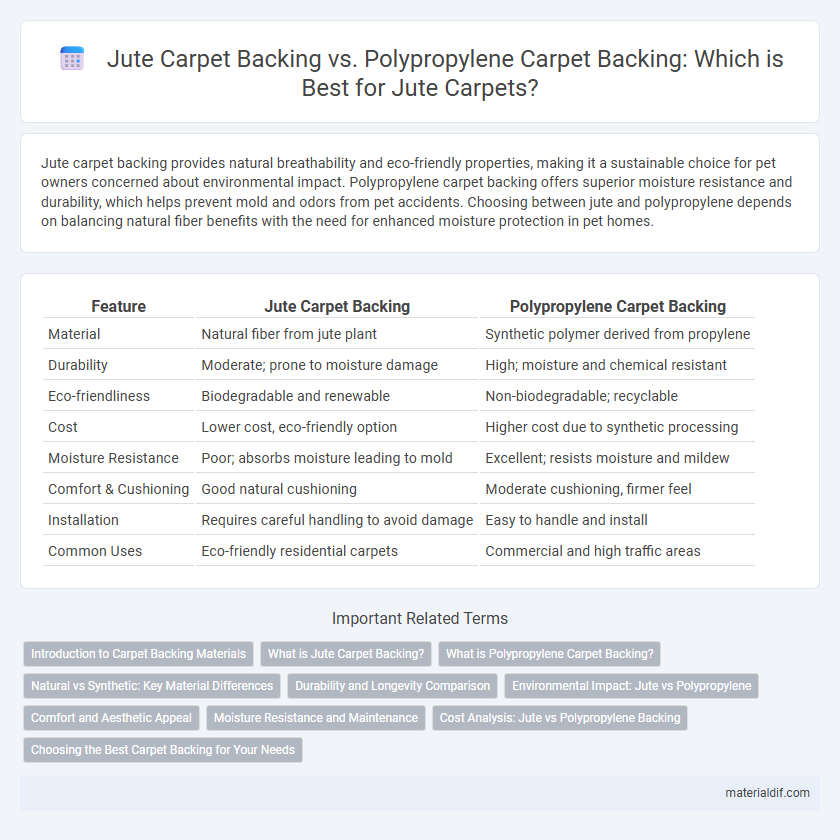Jute carpet backing provides natural breathability and eco-friendly properties, making it a sustainable choice for pet owners concerned about environmental impact. Polypropylene carpet backing offers superior moisture resistance and durability, which helps prevent mold and odors from pet accidents. Choosing between jute and polypropylene depends on balancing natural fiber benefits with the need for enhanced moisture protection in pet homes.
Table of Comparison
| Feature | Jute Carpet Backing | Polypropylene Carpet Backing |
|---|---|---|
| Material | Natural fiber from jute plant | Synthetic polymer derived from propylene |
| Durability | Moderate; prone to moisture damage | High; moisture and chemical resistant |
| Eco-friendliness | Biodegradable and renewable | Non-biodegradable; recyclable |
| Cost | Lower cost, eco-friendly option | Higher cost due to synthetic processing |
| Moisture Resistance | Poor; absorbs moisture leading to mold | Excellent; resists moisture and mildew |
| Comfort & Cushioning | Good natural cushioning | Moderate cushioning, firmer feel |
| Installation | Requires careful handling to avoid damage | Easy to handle and install |
| Common Uses | Eco-friendly residential carpets | Commercial and high traffic areas |
Introduction to Carpet Backing Materials
Jute carpet backing provides a natural, biodegradable, and breathable foundation that enhances carpet durability and comfort, making it an eco-friendly choice. Polypropylene carpet backing offers superior moisture resistance and durability, ideal for high-traffic areas and commercial use due to its synthetic, stain-resistant properties. Selecting the right carpet backing material depends on factors like environmental impact, durability requirements, and intended use, with jute favoring sustainability and polypropylene emphasizing resilience.
What is Jute Carpet Backing?
Jute carpet backing is a natural fiber layer derived from the jute plant, renowned for its eco-friendly and biodegradable properties. It offers excellent moisture absorbance and cushioning, enhancing carpet durability and comfort underfoot. Compared to polypropylene carpet backing, jute provides superior breathability and sustainability, making it a preferred choice for environmentally conscious flooring solutions.
What is Polypropylene Carpet Backing?
Polypropylene carpet backing is a synthetic material used as a durable and moisture-resistant base for carpets, ensuring dimensional stability and preventing carpet deformation. It offers superior resistance to mold, mildew, and chemicals compared to natural jute backing, making it ideal for high-traffic and damp environments. Polypropylene backing also provides enhanced cushioning and noise absorption, contributing to overall carpet longevity and comfort.
Natural vs Synthetic: Key Material Differences
Jute carpet backing is made from natural fibers derived from the jute plant, offering biodegradability, breathability, and moisture absorption, which contribute to a more eco-friendly and comfortable indoor environment. Polypropylene carpet backing utilizes synthetic polymers, providing higher resistance to moisture, mildew, and wear, but lacks the renewable and biodegradable qualities found in jute. The choice between jute and polypropylene hinges on prioritizing natural sustainability and comfort versus synthetic durability and moisture resistance.
Durability and Longevity Comparison
Jute carpet backing offers natural breathability and biodegradability but tends to absorb moisture, leading to faster deterioration and shorter lifespan compared to polypropylene backing. Polypropylene carpet backing provides superior durability, resisting mold, moisture, and wear, resulting in extended longevity for carpets in high-traffic areas. Choosing polypropylene enhances carpet performance and maintenance ease, ensuring long-term resilience in diverse environmental conditions.
Environmental Impact: Jute vs Polypropylene
Jute carpet backing is biodegradable and renewable, significantly reducing environmental impact compared to polypropylene, which is derived from non-renewable petroleum and contributes to microplastic pollution. The natural fibers in jute decompose naturally, promoting soil health and reducing landfill waste, whereas polypropylene backing can persist in the environment for hundreds of years. Choosing jute backing supports sustainable manufacturing and lowers the carbon footprint associated with carpet production and disposal.
Comfort and Aesthetic Appeal
Jute carpet backing offers superior comfort due to its natural fibers, providing a soft and breathable underlayer that enhances the tactile experience of carpets. In contrast, polypropylene carpet backing provides durability but lacks the same level of cushioning and natural warmth, which can affect overall carpet comfort. Aesthetically, jute backing supports a more traditional, eco-friendly appearance while polypropylene backing tends to be less visible but offers a more utilitarian and synthetic look.
Moisture Resistance and Maintenance
Jute carpet backing absorbs moisture easily, leading to potential mold and mildew growth, which requires frequent drying and careful maintenance. In contrast, polypropylene carpet backing offers superior moisture resistance, preventing water absorption and reducing the risk of damage, making it easier to clean and maintain in damp environments. The durability and low maintenance of polypropylene make it a preferred choice for high-humidity areas compared to jute.
Cost Analysis: Jute vs Polypropylene Backing
Jute carpet backing is generally more cost-effective due to its natural fiber composition and lower manufacturing expenses, making it an affordable option for eco-conscious consumers. Polypropylene backing, while slightly more expensive, offers increased durability and moisture resistance, often justifying the higher initial investment in high-traffic areas. Comparing overall lifecycle costs, jute backing requires more maintenance and replacement over time, whereas polypropylene provides longer-lasting performance with reduced long-term expenses.
Choosing the Best Carpet Backing for Your Needs
Jute carpet backing offers excellent breathability and natural biodegradability, making it ideal for eco-conscious homeowners seeking sustainable flooring options. Polypropylene carpet backing provides superior moisture resistance and durability, perfect for high-traffic areas or spaces prone to spills and humidity. Assess your environment and maintenance preferences to determine whether the natural resilience of jute or the robust, water-resistant properties of polypropylene best meet your carpet backing needs.
Jute Carpet Backing vs Polypropylene Carpet Backing Infographic

 materialdif.com
materialdif.com